

Beegin started as a university project in 2016 with the goal of developing an accessible (low-tech/low-cost) and sustainable (socially, economically and environmentally) beekeeping system. Through intensive participatory research and field testing a novel approach to beekeeping was realised - using six criteria (durability, weight, insulation, toxicity, manufacturing & cost/price) to produce a new kind of technology.
The design research encompassed my Honours and Masters in Industrial Design, wherein I specialized and contributed to the fields of Design for Impact, Appropriate Technology, Beekeeping Technology, Capabilities Approach, Human-Centered Design, Social Innovation, Implementation for Impact and design in the context of South Africa (a developing nation).
The Appropriate Beekeeping Technology system (outcome of the 3 years of research and development) is based on a lightweight-concrete beehive and the moulding tools for producing the hives - providing beekeepers with and alternative to wooden hives, that they can make themselves. With fewer risks, higher productivity, greater longevity and production autonomy these hives can create profitable beekeeping businesses.
This portfolio piece will serve as a summary of the design development behind the Beegin project - which is ongoing. Find out more at http://www.beegin.co.za/
- Ivan Leroy Brown


The Bee Bunka is a lightweight-concrete, Langstroth style beehive.
Developed through a highly iterative, participatory design process, this new type of hive is the core of a revolutionary new approach to beekeeping technology. Dubbed 'Appropriate Beekeeping Technology', this new system provides increased sustainability and accessibility in the social, economic and environmental spheres that make up the modern beekeeping industry.










There are currently over 3200 Bee Bunkas being used in apiaries around the world.
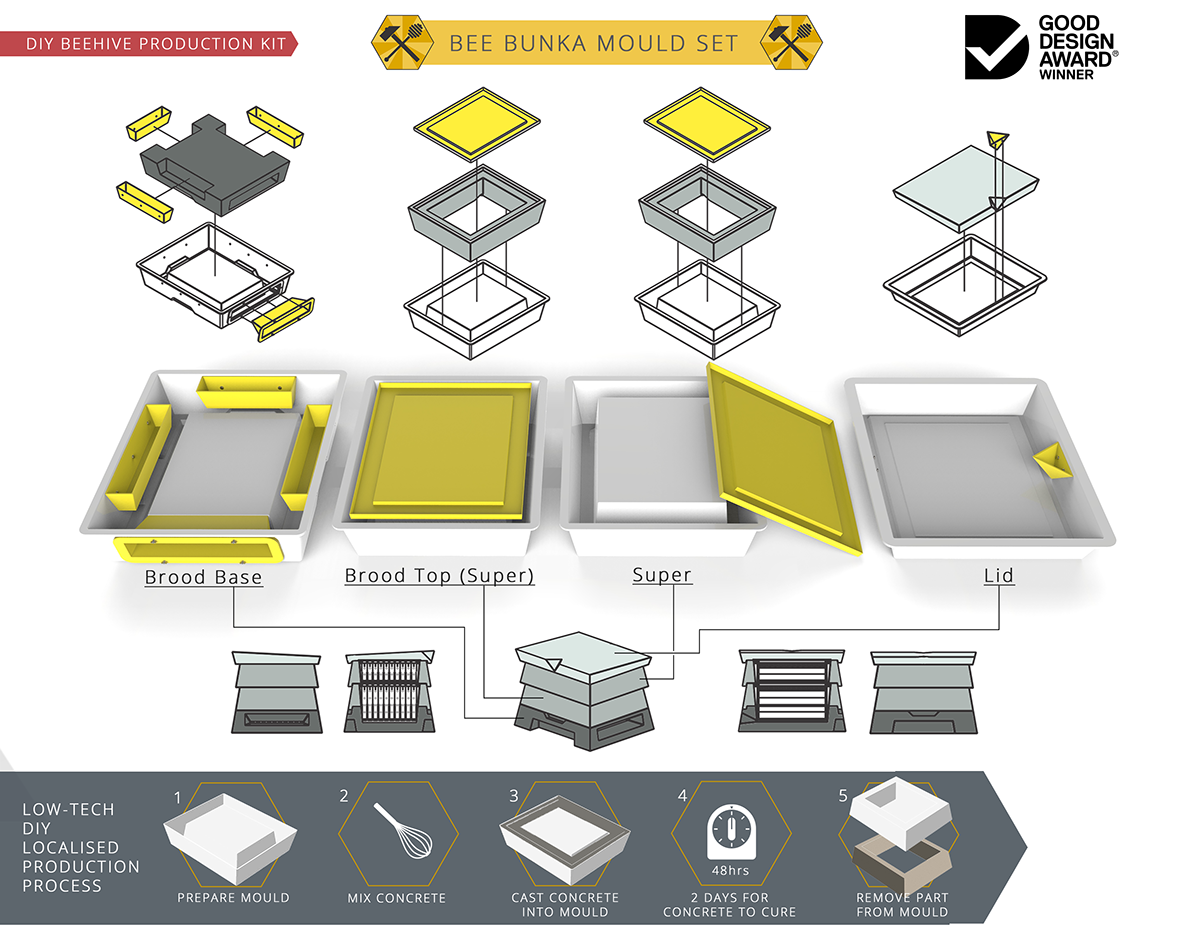
The Bee Bunka is only the result. The real innovation lies in Beegins main product - the Bee Bunka Mould Set. Using this set of 3 low-tech, tray-moulds beekeepers, farmers and entrepreneurs anywhere can make high-quality, durable, low-cost Bee Bunkas. As easy as baking a cake, you simply follow the instructions, mix the materials and pump beehives out.








To date Beegin has delivered over 105 mould sets to clients in 13 different countries. These clients are pioneers and early-adopters who have begun making, using and selling Bee Bunkas.

MINI-DISSERTATION JUN-NOV 2015
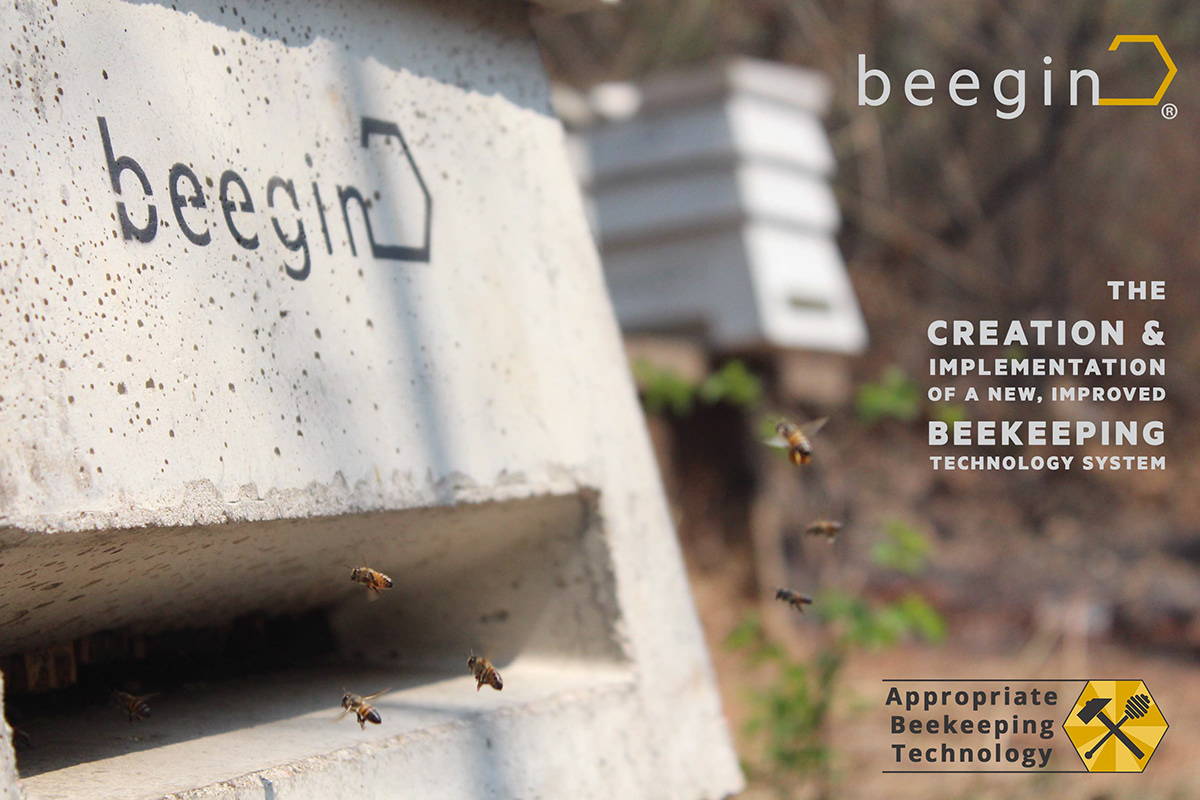
When I first started this project I was looking at opportunities to help increase the capabilities of small-scale farmers. Several participants in the precursory study indicated their desire to raise bees and produce honey. Some participants had already attempted to set up apiaries, with generally poor results. I began to look into the challenges facing emerging beekeepers, broadening the study to include beekeepers, development organisations, agriculturalists and pollination experts.
At the time, the understanding was that beekeeping was under threat from a number of systemic issues that were not being addressed at a policy level. Cheap honey being imported without levies was driving the market price of honey down. Unregulated transport and renting of beehives for pollination was spreading diseases and parasites across country. Criminal activity was being met with little to no police interest. While millions of dollars in aid and donor funding had been poured into development projects for decades with marginal successful impact achieved.
These issues were combining to impact on the profitability of beekeeping and bee related enterprises. The general problems that beekeepers have always faced had become make-or-break dilemmas. The wooden box and frames used by beekeepers around the world for over a century is not an expensive or complicated piece of technology. However, if beekeeping relies on minimizing costs then the wooden beehive jumps out as an asset that keeps on costing the beekeeper.

When I spoke with beekeepers and farmers the problems became clear. Below are some of the photos I took while interviewing participants and visiting sites. The commercial beekeeper who had been keeping well documented records attested to a 30% annual attrition rate with their beehives, due either to badgers, thieves, vandals, fires, extreme weather or a number of other occasional problems like termites and disease outbreaks. What interested me immediately was how, for each problem, each beekeeper had their own unique way of trying to solve it. I saw countless stand design for keeping crawling insects out of the hives. Various locking systems for keeping the hives closed. Steel reinforcement for lids, box corners, frame joints and entrance openings. Beekeepers often built cages, fences and structures around their hives to keep them safe and some beekeepers had even begun making their hives from concrete.














Beehives are the most numerous and cumulatively expensive item of equipment that beekeepers use. A beehive is used to house a honey producing swarm of bees, with removable wooden frames or slats that allow a beekeeper to easily inspect, manage and harvest. The hives are generally standardised around 'Bee-Space' - a natural measurement based on optimal distance between wax combs that encourages bees to build in the intended manor. The beehive is also the item with the most variation in design and opportunity for alteration. The project started looking as though it would focus (at least initially) on the beehive as a crucial component to any successful beekeeping endeavor, so I combed through books and articles to develop a series of themes, requirements and criteria surrounding the design of beehives. I was, all the while, looking at beehive design through a lense of appropriate technology - focusing on factors that influenced the sustainability and accessibility of the technology. The outcome was the 8 themes below and a basic process for novices to enter into beekeeping.

Using these themes I analysed existing beehives, which I separated into three main categories: standard (universally adopted and commercially viable), apicentric (bee friendly systems) and modern (new, critically acclaimed designs).
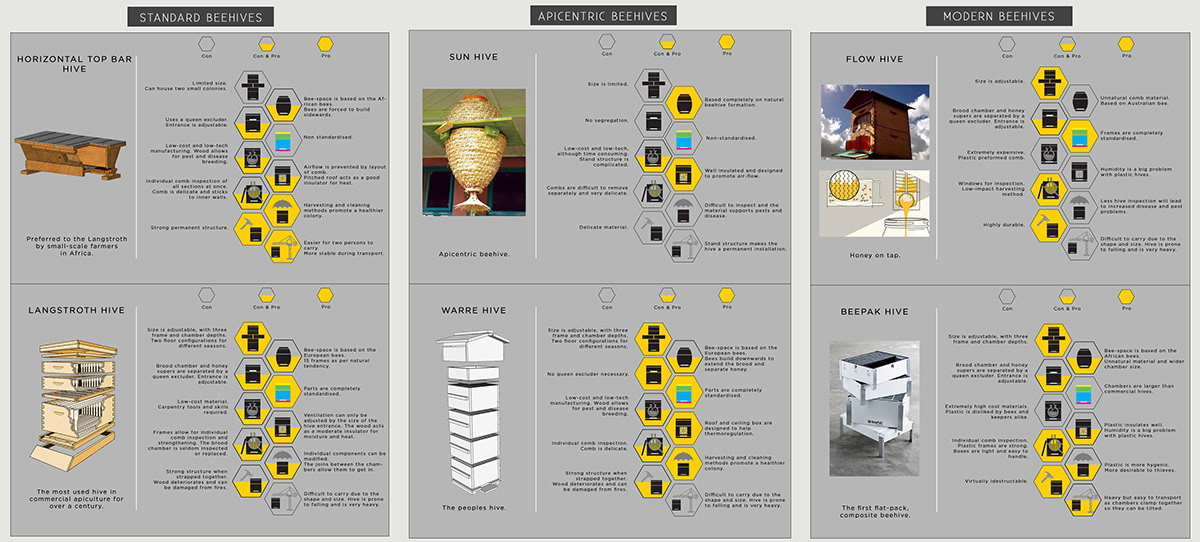
I took a deeper look at beehive technology, assessing why design decisions had been made in the past and how open to adjustment they were.

Although beehives are designed under certain constraints the type of material they are made from can vary. Beehives originally were made from cylinders of tree bark and then clay pots - early beekeeping dates back over 5000 years. Although currently beehives are mainly made from pine (treated with chemicals), there are beehives that are made from plastic, foam, steel, glass, ceramics, concrete and cardboard. It became clear to me that the main factor that held sway over all themes would be the choice in material. So i conducted a study analysing 18 different possible beehive construction materials. The summary of the study is available at the link below, while the table below demonstrates the findings:

In the end I decided, with help from my beekeeper and farmer participants groups, that I would attempt to develop a beehive from cardboard and lightweight-concrete.

In the development process we decided that the cardboard hive should represent a temporary entry-level hive - a cheap, simple beehive for beginners to use as a gateway into beekeeping. While the lightweight-concrete hive would be a permanent device able to take over from the cardboard hive eventually.

The outcome of the development and user testing of various prototypes and concepts were the two hives below. I won't spend time explaining each design in detail. They had numerous features and carefully considered aspects that made them both innovative and standardised within the beekeeping system. However, these design represented only a initial concept that could be tested in the field to assess the validity of the assumptions underpinning their fruition. The cardboard hive was a version of a catch-box that could be expanded. The lightweight-concrete hive was a version of a Langstroth hive that could be moulded easily. Those were the main points of the exercise.
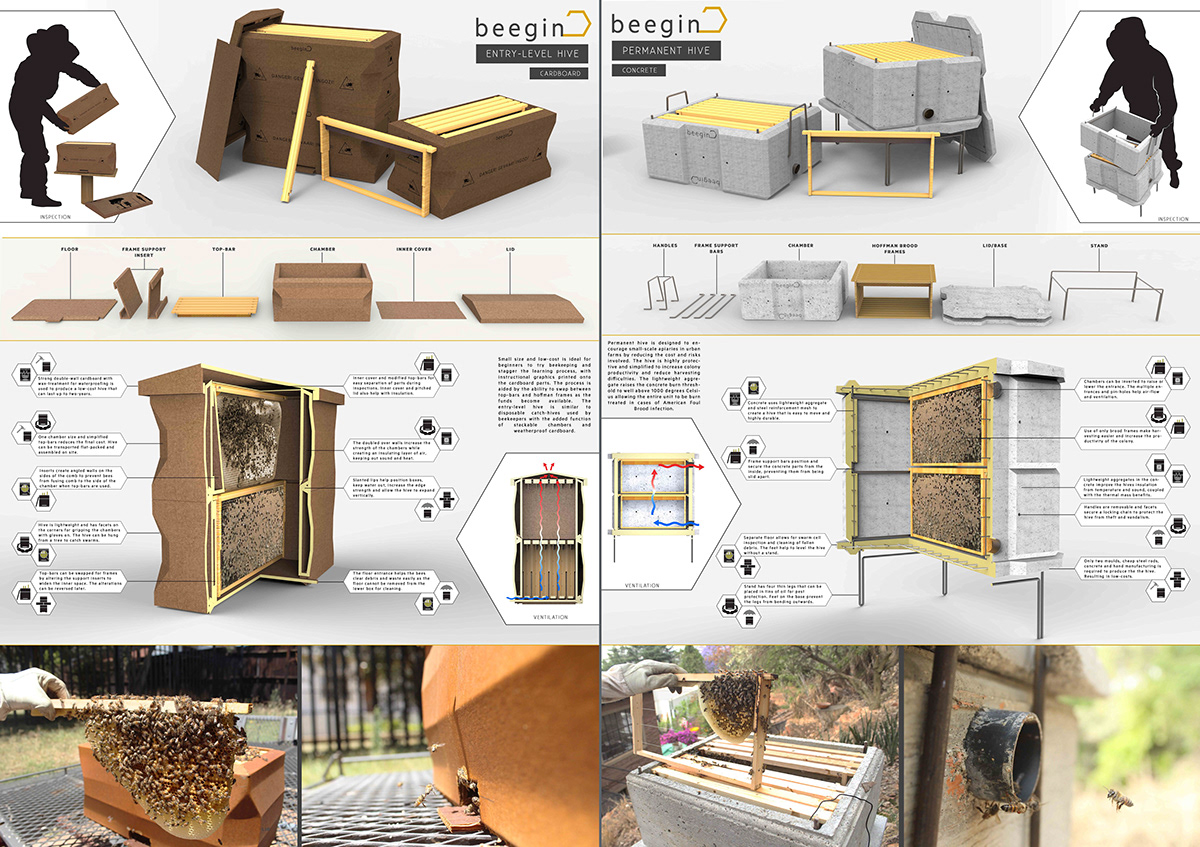
I made prototypes of both and immediately began testing them alongside existing beehives in their category. The outcomes above were the product deliverables for my minor dissertation titled "An Improved Beehive Design to Support Local Urban Agriculture", which earned me a spot in the Masters program in the Industrial Design department where I would continue to test and develop this beekeeping system.

MASTERS DISSERTATION 2016-2017

My proposal for a Masters design research project - in poster form:
Aim: Have a group of participants to test the technology - making their own beehives and using them for at least a year. Testing the hypothesis that these beehives could improve the capabilities of farmers and beekeepers and be implemented on a larger scale in different contexts.

What followed was a 2 year, highly-participatory, iterative process that was divided into 3 stages - implementation, observation and refinement. The charts below were used to illustrate this process:
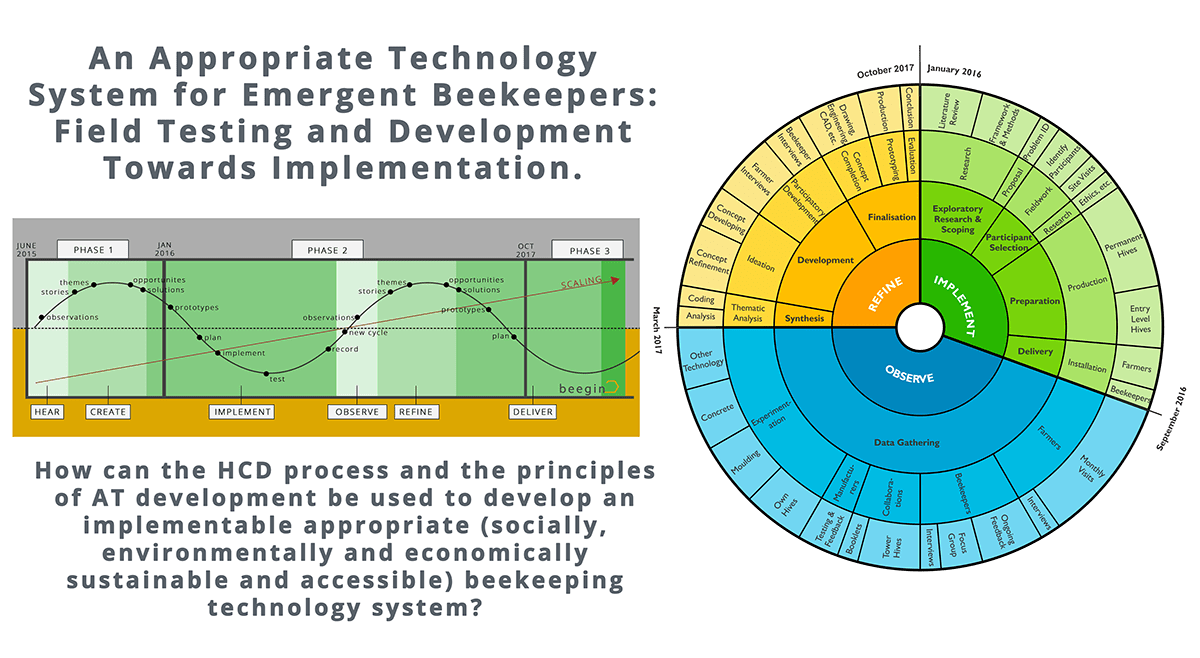
The first step in the field testing was to find a diverse group of farmer and beekeeper participants. The farmers consisted of 2 women and 4 men, all full-time small-scale farmers from the greater metropolitan area of Johannesburg. The beekeepers consisted of 3 commercial, 2 hobbyist and 1 retired bee professional/researcher. I (author) also set up several beehives in both urban and rural areas to conduct additional studies.


The participants were all given the entry-level cardboard beehives and assisted in setting them up as catch-boxes on their sites. This involved making 20 prototypes of the beehive. The catch boxes worked well in most cases attracting swarms within the first few weeks. Although their durability rapidly became a problem.












While we waited for the catch boxes to do their work, we started making the lightweight concrete beehives that would take over from their cardboard hives later on. I set up focus groups where the participants would observe the production process over two days. Then left the moulds with the participants for a few weeks (with materials) to see how they would fair at making hives themselves.










Through these two steps we started to find some problems. The cardboard hives managed to attract bees and withstand weathering, however when it came time to transfer the swarms to the concrete hives we found that the bees had eaten away large sections of the internal structures, compromising the boxes. What I had hoped would be reusable beehives became single-use - making the entry-level hives as economically infeasible.
The problems found when moulding the concrete hives were not so fatal. The participants were able to repeatedly produce the hives. Issues included: the long time it took to assemble and strip the moulds, the fragility of of the thin concrete components, rusting causing mould parts to stick, screws becoming stuck, etc.











Once the swarms had reached a suitable stage of development we transferred them to concrete hives. The intention was to try and harvest some honey from the cardboard hives at the transition point if the swarms were strong enough - despite leaving them for longer than intended only 2 were. The swarms performed much better once in the concrete hives, with honey being harvested from nearly all of them by the end of the study.




Before moving on I addressed the research questions. In summary: Does the ABT outperform existing technology in beekeeping pratices? Yes. Does the ABT effectively help small-scale farmers take up beekeeping as a supplementary activity? No. Can the ABT be improved so that it achieves the goals set out by this study? Yes. While the lightweight concrete beehive and production tools were successful, the initiation system and entry-level beehive were not. It would be better to start off with the right tools, enabling a profit to be made quicker. How the farmers accessed the more expensive tools would be a matter of business strategy, but it was the correct way to approach beekeeping systems. In terms of the concrete hives and moulds it was potentially possible to make a cheaper and simpler system for low-income farmers and to refine the existing tools. This would require further participatory design and research work.


A very long story short, after coding all of the data from the research (including hours of interviews) I started to map the issues and sort them into groups. As a designer my capabilities lay in design fields, so I decided to separate them into areas of design. Once I had the groups I realised that to achieve the requirements of one group often meant sacrificing another's. In order to produce a viable outcome I had to establish a hierarchy for the groups - where decisions for antecedent groups could not be countermanded by work done in descendant areas. The overarching guideline and main group would encompass the aims of the study - to find an appropriate beekeeping technology system, named the ' Macro System'. The key innovation, and fate of the project, now lay in lightweight concrete being a suitable material for beehives. So I decided to set the 'Material Design' as the alpha group, forcing the rest to obey the restrictions that lightweight concrete imposed - it has to be thick, limited corners/sharp edges, the moulded surfaces are the only smooth ones, etc. Followed by 'Tool Design' as the key to successfully forming the lightweight concrete - simple one-piece moulds only, mould material and its manufacturing requirements, etc. Now when I looked at the beekeeping system ('Micro') and then the beehive design itself ('Product') I already had certain inalienable decisions; the hives were going to be heavy, they had to have tapering walls, the parts could only be a certain height, there were limits to internal and external detail. Yes, it would be possible to make a beehive within these requirements, but I would have to sacrifice some of the traits of the venerable Langstroth beehive, yielding to the more important factors of beekeeping in Africa which demand Lightweight concrete and DIY moulds.


Though brainstorming and sketch development I worked to simplify the mould design, improve the beehive strength and satisfy the other various constraints. Through prototyping I experimented with various materials for making moulds that would be low-cost and durable enough. I began to look at ways to use tray-moulds (1-part moulds) to make the beehive components. Initially I used sheet metal to make the moulds, but while making smaller prototypes I began using vacuum formed plastic. I found that the concrete parts coming out of the plastic moulds were of a much higher quality, and the moulds were easier to make and harder to break. So I pursued the vac-forming manufacturing process on a larger scale to make the moulds. This required the hives to adopt a tapered form both inside and out.




















When I showed the rough concepts and prototypes to the participants there was a general consensus on which was the correct direction. The Langstroth and HTB hives, and tehir respective moulds, as shown below satisfied the design criteria and the participants equally.


The final moulds I made as part of the research outcomes still featured sheet metal components as I lacked access to a vacuum machine of the correct size. This problem would inevitably result in me adjusting the design of the Langstroth hive during the commercialization of Beegin. Likewise the HTB hive moulds proved infeasible to carry out in the same manner as the Langstroth ones, and have since been under revision and testing using other materials and designs.








What followed was refining these into working prototypes and entering into another phase of testing and refinement. This next phase saw the Beegin project scaling to a commercial enterprise, producing hundreds of Bunka beehives and selling them to beekeepers, farmers and organisations. Once the efficacy of the beehives had been proven (16 months later) I began producing the moulds and selling them taking us to where Beegin is at the start of this portfolio.








BEEGIN - BEE BUNKA MOULDS WINS AUSTRALIA’S COVETED GOOD DESIGN AWARD FOR DESIGN EXCELLENCE.
The winners of Australia's peak industry design awards – the highest honour for design and innovation in the country were announced at The Star on 11 July at the 61st annual Good Design Awards Ceremony.
Beegin - Bee Bunka Moulds received a prestigious Good Design Award Winner Accolade in the Social Impact category in recognition for outstanding design and innovation.
The annual Good Design Awards is Australia’s most prestigious international Awards for design and innovation with a proud history dating back to 1958. The Awards celebrate the best new products and services on the Australian market, excellence in architectural design, engineering, fashion, digital and communication design and reward emerging areas of design strategy, social impact and design entrepreneurship.
The Good Design Awards Jury spent several days evaluating each entry according to a strict set of design criteria which covers ‘good design’, ‘design innovation’ and ‘design impact’. Projects recognised with a Good Design Award must demonstrate excellence in all areas and convince the Jury they are worthy of recognition.
The Good Design Awards Jury praised Beegin - Bee Bunka Moulds commenting: “ The Jury applauds the iterative user-centered design process utilised in the development of Beegin. Meeting the needs of a diverse group of users, including beekeepers, farmers and marginalized, rural communities. Beegin, successfully provides superior moulds at a price accessible to these communities, importantly working with key organisations to facilitate the business development opportunities with the Beegin beehive system. ”
The Good Design Awards attracted a record number of submissions with close to 700 design projects evaluated in this year’s international design awards.

